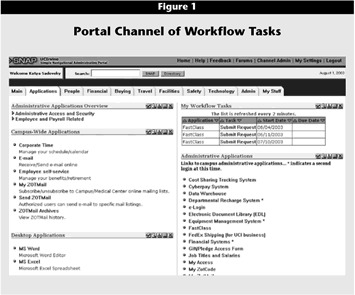With a new wave of campus IT solutions comes a familiar challenge: How do you encourage and help build distributed applications without being overrun by stovepipe solutions? Anticipating significant enrollment growth (5 percent per year) for the next several years, double-digit annual growth in funded research, and little chance that resources will be available to address increased workload, the University of California Irvine continues to streamline and simplify business processes as part of administrative technology planning at the university.1
Portal as First Step
An effective portal strategy encompasses the reuse of common infrastructure such as directory services, authentication, search, and content management systems. UC Irvine’s implementation of the open source uPortal software (http://snap.uci.edu/), which went live in summer 2002, improved client services by simplifying access to campus business content and related applications, but it lacked the infrastructure to provide a common framework for handling routing and approvals and other key process automations that define workflow. In this context, workflow is viewed as the automation of a business process during which documents or tasks, passed from one participant to another, follow a set of procedural rules.
Decoupling the core infrastructure of workflow from stovepipes—non-integrated applications—has significant advantages and is particularly important in a portal environment. The issue for UC Irvine became how best to incorporate workflow in the campus portal implementation.
Defining the Workflow Channel
Channels are one means of personalizing the portal experience. Users can browse and subscribe to the information channels—snippets of Web content—that they’re interested in receiving. To date, there are 36 channels available through the UC Irvine portal. Choices include targeted information, such as "for new employees" and "for staff who supervise," to general community information, such as "Irvine weather" and "Orange County traffic map." Some channels are mandatory for certain groups of users, some are available for public subscription, and others are only available to an authorized group of individuals. With channels already available within uPortal, the next step was to determine how to leverage the channel interface to collect and display workflow tasks.
UC Irvine campus business processes included the requirements to
- Assign tasks to a single user or a group of designated users for routing and approval
- Track the start/end time and duration of a task or workflow
- Produce an analysis report to track any bottleneck in the process
- Track and report task escalations
After thorough evaluation, we chose the solution of integrating a third-party workflow engine within uPortal in order to add a workflow channel to the portal. We looked at the workflow engines Fujitsu iFlow, Oak Grove Software Workflow Engine, and Drala. The Java-based, off-the-shelf solution to workflow management that we selected, Drala, enables us to abstract the workflow processing while providing the flexibility to further modify business rules. The engine’s task list, displayed as a channel within uPortal, is used as the access point to all other workflow-enabled applications.
A workflow infrastructure also enhances security by explicitly stating when a function should be performed and by whom. The description of a workflow process defines who should perform each step and when, and the events leading up to the execution of this step. Security access restrictions, which depend on the state of the workflow process, are automatically enforced by the engine and off-loaded by applications to the engine for consistent handling.
Enabling the First Application
UC Irvine supervisors and employees alike needed a way out of the cumbersome, paper-bound system of job reclassification. Campus surveys and focus groups determined that the reclassification process needed to be integrated into a Web environment with provision for routing and approval. Our solution to automating job classifications is FastClass, an on-line reclassification submittal process designed as a workflow application. FastClass met all of the qualifications for seamless electronic approvals and routing, and as a result became our first application to use the portal workflow channel.
Integrating the Engine
An application’s business rules, modeled as workflow, are built into the workflow template and executed by the Drala engine at runtime. Data relevant to electronic approvals and routing are the only type of application data accessible to the workflow engine. To make this work, it was critical to understand what constitutes application data and what makes up workflow data.2 We identified a successful pattern with which to separate workflow from the application and are now reusing it for other applications.
The result is a workflow task list displayed to campus users via a portal channel labeled "My Workflow Tasks" (see Figure 1). Users are presented with an aggregated list enabling them to select individual items of work, spanning all workflow-enabled applications. For example, the job reclassification application, FastClass, allows the user to navigate to the appropriate tasks through the uPortal workflow channel. The code reuse also improves our development group’s productivity, freeing more time to develop or enhance other applications.

Click image for larger view.
The Next Step
To build on the success of the FastClass workflow-enabled application, we decided to set up more Human Resources applications as workflow channels this spring. The Campus Temporary Employment Services application is a natural fit. It involves temporary staff, their college and departmental supervisors, and central office Human Resources’ managers using the workflow capabilities to speed up and simplify time-reporting processes. We expect to follow up soon with an existing campus payment-request system and additional applications from the campus business portal.
In Conclusion
By implementing a workflow infrastructure effectively, an organization can streamline processes, improve the user experience, enhance security, and reduce redundant tasks such as role and user management, tracking, reporting, and statistics.
The UC Irvine approach of adding a third-party workflow engine within our existing open source portal implementation has enabled us to create more modular Web applications with a consistent set of automated interfaces and protocols. The aggregated workflow task list provides a more productive work environment for our users and has brought the UC Irvine campus closer to our business portal vision.
